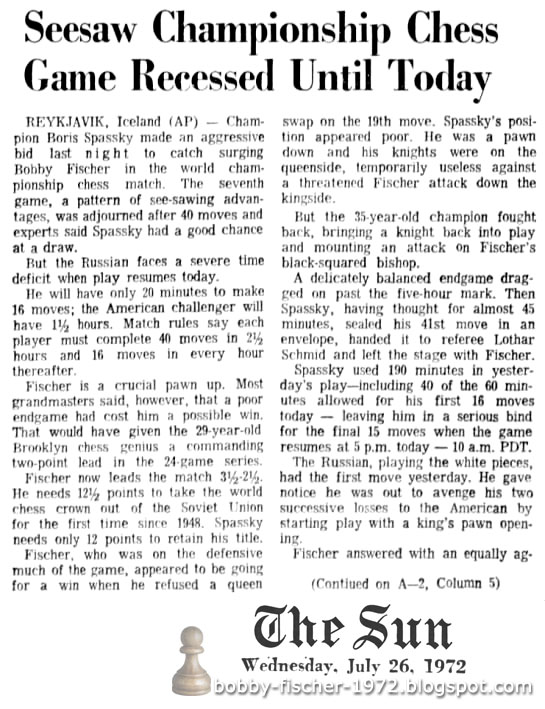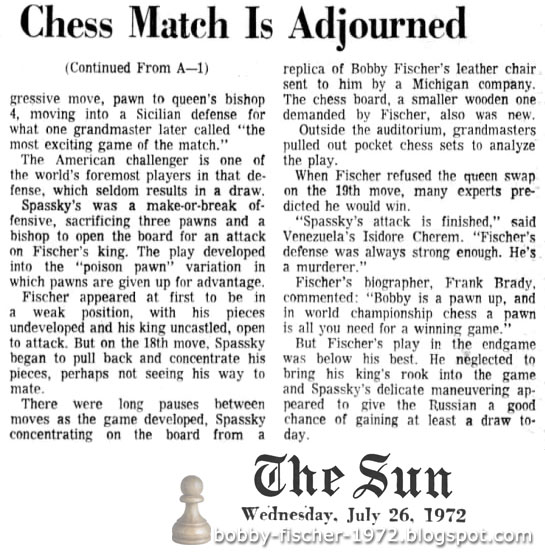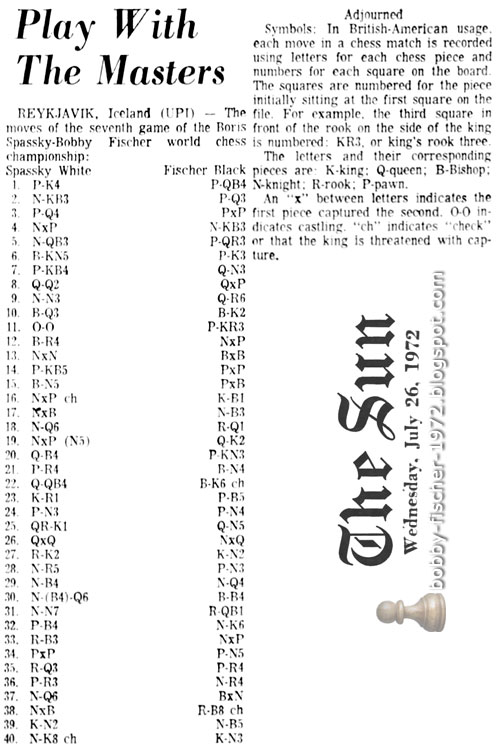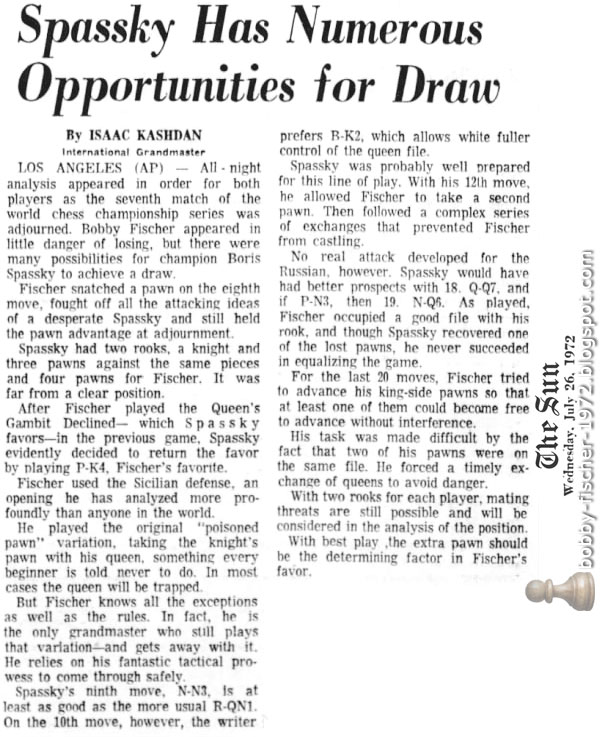The San Bernardino County Sun San Bernardino, California Wednesday, July 26, 1972 - Page 1
Seesaw Championship Chess Game Recessed Until Today
Reykjavik, Iceland (AP)— Champion Boris Spassky made an aggressive bid last night to catch surging Bobby Fischer in the world championship chess match. The seventh game, a pattern of see-sawing advantages, was adjourned after 40 moves and experts said Spassky had a good chance at a draw.
But the Russian faces a severe time deficit when play resumes today.
He will have only 20 minutes to make 16 moves; the American challenger will have 1½ hours. Match rules say each player must complete 40 moves in 2½ hours and 16 movies in every hour thereafter.
Fischer is a crucial pawn up. Most grandmasters said, however, that a poor endgame had cost him a possible win. That would have given the 29-year-old Brooklyn chess genius a commanding two-point lead in the 24-game series.
Fischer now leads the match 3½-2½. He needs 12½ points to take the world chess crown out of the Soviet Union for the first time since 1948. Spassky needs only 12 points to retain his title.
Fischer, who was on the defensive much of the game, appeared to be going for a win when he refused a queen swap on the 19th move. Spassky's position appeared poor. He was a pawn down and his knights were on the queenside, temporarily useless against a threatened Fischer attack down the kingside.
But the 35-year-old champion fought back, bringing a knight back into play and mounting an attack on Fischer's black-squared bishop.
A delicately balanced endgame dragged on past the five-hour mark. Then Spassky, having thought for almost 45 minutes, sealed his 41st move in an envelope, handed it to referee Lothar Schmid and left the stage with Fischer.
Spassky used 190 minutes in yesterday's play—including 40 of the 60 minutes allowed for his first 16 moves today — leaving him in a serious bind for the final 15 moves when the game resumes at 5 p.m. today — 10 a.m. PDT.
The Russian, playing the white pieces, had the first move yesterday. He gave notice he was out to avenge his two successive losses to the American by starting play with a king's pawn opening.
Fischer answered with an equally ag-
(Continued on A-2, Column 5)
The San Bernardino County Sun San Bernardino, California Wednesday, July 26, 1972 - Page 2
Chess Match Is Adjourned
(Continued From A-1)
gressive move, pawn to queen's bishop 4, moving into a Sicilian defense for what one grandmaster later called “the most exciting game of the match.”
The American challenger is one of the world's foremost players in that defensive, sacrificing three pawns and a bishop to open the board for an attack on Fischer's king. The play developed into the “poison pawn” variation in which pawns are given up for advantage.
Fischer appeared at first to be in a weak position, with his pieces undeveloped and his king uncastled, open to attack. But on the 18th move, Spassky began to pull back and concentrate his pieces, perhaps not seeing his way to mate.
There were long pauses between moves as the game developed, Spassky concentrating on the board from a replica of Bobby Fischer's leather chair sent to him by a Michigan company. The chess board, a smaller wooden one demanded by Fischer, also was new.
Outside the auditorium, grandmasters pulled out pocket chess sets to analyze the play.
When Fischer refused the queen swap on the 19th move, many experts predicted he would win.
“Spassky's attack is finished,” said Venezuela's Isidore Cherem. “Fischer's defense was always strong enough. He's a murderer.”
Fischer's biographer, Frank Brady, commented: “Bobby is a pawn up, and in world championship chess a pawn is all you need for a winning game.”
But Fischer's play in the endgame was below his best. He neglected to bring his king's rook into the game and Spassky's delicate maneuvering appeared to give the Russian a good chance of gaining at least a draw today.
The San Bernardino County Sun San Bernardino, California Wednesday, July 26, 1972 - Page 2
Play With The Masters
Reykjavik, Iceland (UPI) — The moves of the seventh game of the Boris Spassky-Bobby Fischer world chess championship:
Adjourned
Symbols: In British-American usage, each move in a chess match is recorded using letters for each chess piece and numbers for each square on the board. The squares are numbered for the piece initially sitting at the first square on the file. For example, the third square in front of the rook on the side of the king is numbered KR3, or king's rook three.
The letters and the corresponding pieces are K-king; Q-queen; B-Bishop; N-knight; R-rook; P-pawn.
An “x” between letters indicates the first piece captured the second. 0-0 indicates castling. “ch” indicates “check” or that the king is threatened with capture.
The San Bernardino County Sun San Bernardino, California Wednesday, July 26, 1972 - Page 2
Spassky Has Numerous Opportunities for Draw
Los Angeles (AP) — All-night analysis appeared in order for both players as the seventh match of the world chess championship series was adjourned. Bobby Fischer appeared in little danger of losing, but there were many possibilities for champion Boris Spassky to achieve a draw.
Fischer snatched a pawn on the eighth move, fought off all the attacking ideas of a desperate Spassky and still held the pawn advantage at adjournment.
Spassky had two rooks, a knight and three pawns against the same pieces and four pawns for Fischer. It was far from a clear position.
After Fischer played the Queen's Gambit Declined—which Spassky favors—in the previous game, Spassky evidently decided to return the favor by playing P-K4, Fischer's favorite.
Fischer used the Sicilian defense, an opening he has analyzed more profoundly than anyone in the world.
He played the original “poisoned pawn” variation, taking the knight's pawn with his queen, something every beginner is told never to do. In most cases the queen will be trapped.
But Fischer knows all the exceptions as well as the rules. In fact, he is the only grandmaster who still plays that variation—and gets away with it. He relies on his fantastic tactical prowess to come through safely.
Spassky's ninth move, N-N3, is at least as good as the more usual R-QN1. On the 10th move, however, the writer prefers B-K2, which allows white fuller control of the queen file.
Spassky was probably well prepared for this line of play. With his 12th move, he allowed Fischer to take a second pawn. Then followed a complex series of exchanges that prevented Fischer from castling.
No real attack developed for the Russian, however. Spassky would have had better prospects with 18. Q-Q7, and if P-N3, then 19. N-Q6. As played, Fischer occupied a good file with his rook, and though Spassky recovered one of the lost pawns, he never succeeded in equalizing the game.
For the last 20 moves, Fischer tried to advance his king-side pawns so that at least one of them could become free to advance without interference.
His task was made difficult by the fact that two of his pawns were on the same file. He forced a timely exchange of queens to avoid danger.
With two rooks for each player, mating threats are still possible and will be considered in the analysis of the position.
With best play the extra pawn should be the determining factor in Fischer's favor.



























